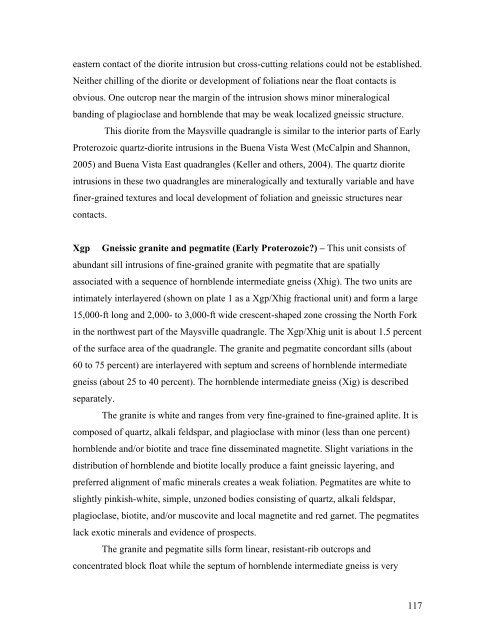Geologic Map of the Maysville Quadrangle, Chaffee County, Colorado
Geologic Map of the Maysville Quadrangle, Chaffee County, Colorado
Geologic Map of the Maysville Quadrangle, Chaffee County, Colorado
You also want an ePaper? Increase the reach of your titles
YUMPU automatically turns print PDFs into web optimized ePapers that Google loves.
eastern contact <strong>of</strong> <strong>the</strong> diorite intrusion but cross-cutting relations could not be established.<br />
Nei<strong>the</strong>r chilling <strong>of</strong> <strong>the</strong> diorite or development <strong>of</strong> foliations near <strong>the</strong> float contacts is<br />
obvious. One outcrop near <strong>the</strong> margin <strong>of</strong> <strong>the</strong> intrusion shows minor mineralogical<br />
banding <strong>of</strong> plagioclase and hornblende that may be weak localized gneissic structure.<br />
This diorite from <strong>the</strong> <strong>Maysville</strong> quadrangle is similar to <strong>the</strong> interior parts <strong>of</strong> Early<br />
Proterozoic quartz-diorite intrusions in <strong>the</strong> Buena Vista West (McCalpin and Shannon,<br />
2005) and Buena Vista East quadrangles (Keller and o<strong>the</strong>rs, 2004). The quartz diorite<br />
intrusions in <strong>the</strong>se two quadrangles are mineralogically and texturally variable and have<br />
finer-grained textures and local development <strong>of</strong> foliation and gneissic structures near<br />
contacts.<br />
Xgp Gneissic granite and pegmatite (Early Proterozoic) – This unit consists <strong>of</strong><br />
abundant sill intrusions <strong>of</strong> fine-grained granite with pegmatite that are spatially<br />
associated with a sequence <strong>of</strong> hornblende intermediate gneiss (Xhig). The two units are<br />
intimately interlayered (shown on plate 1 as a Xgp/Xhig fractional unit) and form a large<br />
15,000-ft long and 2,000- to 3,000-ft wide crescent-shaped zone crossing <strong>the</strong> North Fork<br />
in <strong>the</strong> northwest part <strong>of</strong> <strong>the</strong> <strong>Maysville</strong> quadrangle. The Xgp/Xhig unit is about 1.5 percent<br />
<strong>of</strong> <strong>the</strong> surface area <strong>of</strong> <strong>the</strong> quadrangle. The granite and pegmatite concordant sills (about<br />
60 to 75 percent) are interlayered with septum and screens <strong>of</strong> hornblende intermediate<br />
gneiss (about 25 to 40 percent). The hornblende intermediate gneiss (Xig) is described<br />
separately.<br />
The granite is white and ranges from very fine-grained to fine-grained aplite. It is<br />
composed <strong>of</strong> quartz, alkali feldspar, and plagioclase with minor (less than one percent)<br />
hornblende and/or biotite and trace fine disseminated magnetite. Slight variations in <strong>the</strong><br />
distribution <strong>of</strong> hornblende and biotite locally produce a faint gneissic layering, and<br />
preferred alignment <strong>of</strong> mafic minerals creates a weak foliation. Pegmatites are white to<br />
slightly pinkish-white, simple, unzoned bodies consisting <strong>of</strong> quartz, alkali feldspar,<br />
plagioclase, biotite, and/or muscovite and local magnetite and red garnet. The pegmatites<br />
lack exotic minerals and evidence <strong>of</strong> prospects.<br />
The granite and pegmatite sills form linear, resistant-rib outcrops and<br />
concentrated block float while <strong>the</strong> septum <strong>of</strong> hornblende intermediate gneiss is very<br />
117




